Hospitality Industry: Managing Financial Resources and Reporting
VerifiedAdded on 2023/06/16
|12
|3096
|72
Report
AI Summary
This report provides a detailed analysis of financial resource management within the hospitality sector. It begins by explaining Generally Accepted Accounting Principles (GAAP) and their importance in standardizing accounting practices across industries, highlighting key principles such as regularity, consistency, sincerity, and prudence. The report identifies various users of financial statements, including company management, customers, competitors, employees, governments, and unions, and discusses their specific information needs. It then examines the significance of income statements, balance sheets, and cash flow statements for loan creditors and trade creditors, emphasizing the importance of ratios derived from these statements. Furthermore, the report describes the components that supplement financial statements in an annual report, such as assets, liabilities, equities, and revenues, and discusses financial reporting concepts. The report concludes with an interpretation of financial statements using financial ratios to compare two years of performance. Desklib is the perfect platform for students seeking similar solved assignments and study resources.

Managing Financial
Resources in Hospitality
Industry
1
Resources in Hospitality
Industry
1
Paraphrase This Document
Need a fresh take? Get an instant paraphrase of this document with our AI Paraphraser
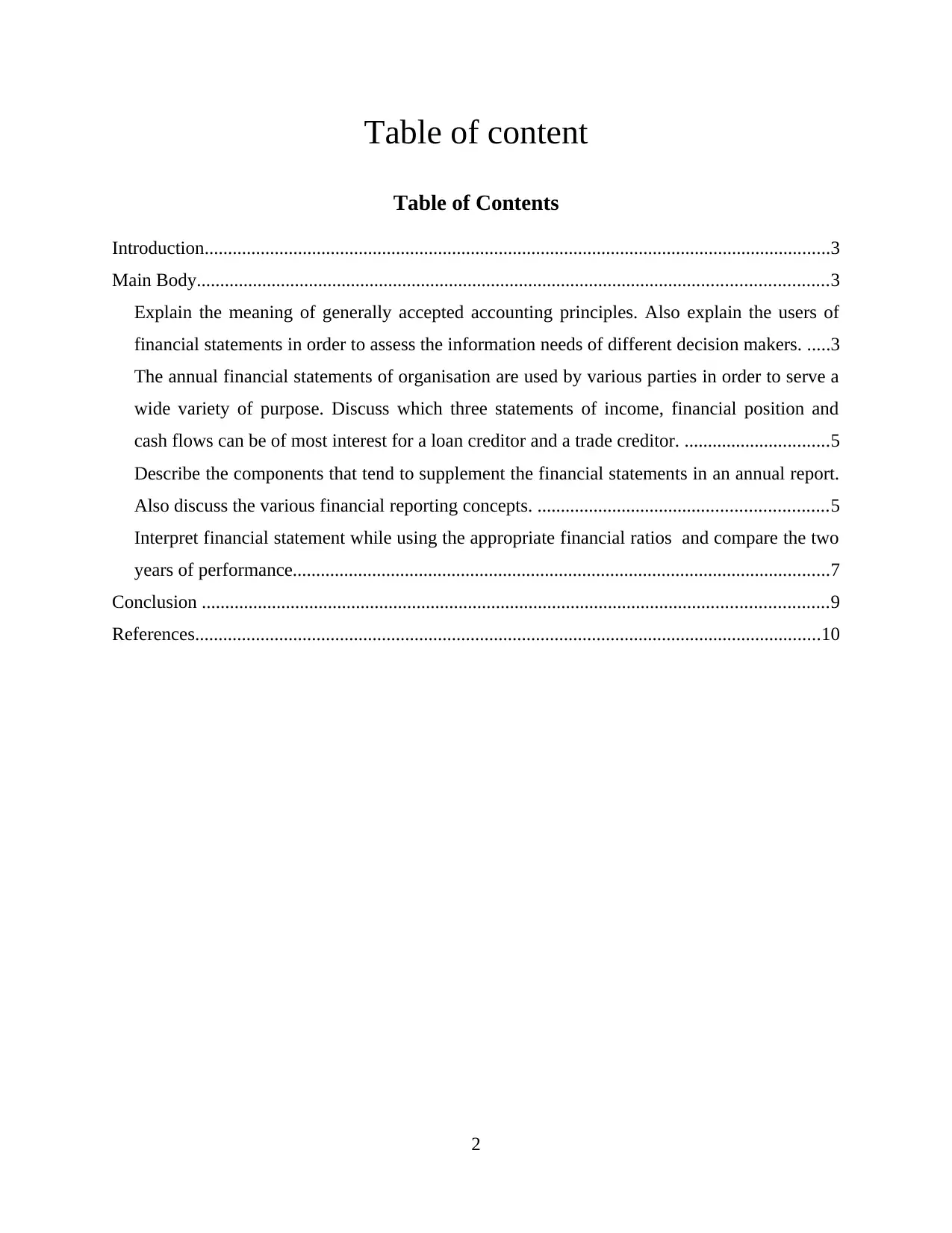
Table of content
Table of Contents
Introduction......................................................................................................................................3
Main Body.......................................................................................................................................3
Explain the meaning of generally accepted accounting principles. Also explain the users of
financial statements in order to assess the information needs of different decision makers. .....3
The annual financial statements of organisation are used by various parties in order to serve a
wide variety of purpose. Discuss which three statements of income, financial position and
cash flows can be of most interest for a loan creditor and a trade creditor. ...............................5
Describe the components that tend to supplement the financial statements in an annual report.
Also discuss the various financial reporting concepts. ..............................................................5
Interpret financial statement while using the appropriate financial ratios and compare the two
years of performance...................................................................................................................7
Conclusion ......................................................................................................................................9
References......................................................................................................................................10
2
Table of Contents
Introduction......................................................................................................................................3
Main Body.......................................................................................................................................3
Explain the meaning of generally accepted accounting principles. Also explain the users of
financial statements in order to assess the information needs of different decision makers. .....3
The annual financial statements of organisation are used by various parties in order to serve a
wide variety of purpose. Discuss which three statements of income, financial position and
cash flows can be of most interest for a loan creditor and a trade creditor. ...............................5
Describe the components that tend to supplement the financial statements in an annual report.
Also discuss the various financial reporting concepts. ..............................................................5
Interpret financial statement while using the appropriate financial ratios and compare the two
years of performance...................................................................................................................7
Conclusion ......................................................................................................................................9
References......................................................................................................................................10
2
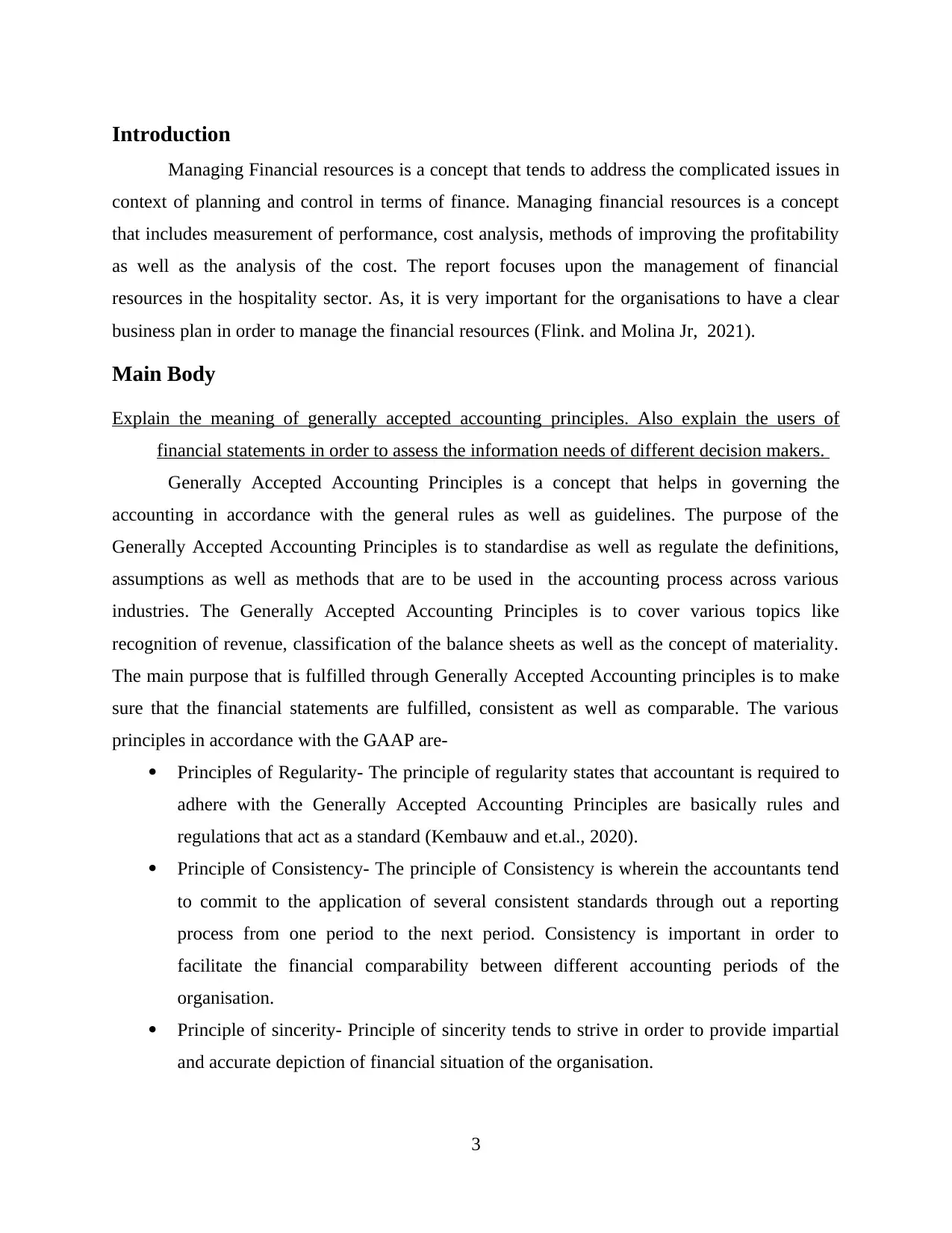
Introduction
Managing Financial resources is a concept that tends to address the complicated issues in
context of planning and control in terms of finance. Managing financial resources is a concept
that includes measurement of performance, cost analysis, methods of improving the profitability
as well as the analysis of the cost. The report focuses upon the management of financial
resources in the hospitality sector. As, it is very important for the organisations to have a clear
business plan in order to manage the financial resources (Flink. and Molina Jr, 2021).
Main Body
Explain the meaning of generally accepted accounting principles. Also explain the users of
financial statements in order to assess the information needs of different decision makers.
Generally Accepted Accounting Principles is a concept that helps in governing the
accounting in accordance with the general rules as well as guidelines. The purpose of the
Generally Accepted Accounting Principles is to standardise as well as regulate the definitions,
assumptions as well as methods that are to be used in the accounting process across various
industries. The Generally Accepted Accounting Principles is to cover various topics like
recognition of revenue, classification of the balance sheets as well as the concept of materiality.
The main purpose that is fulfilled through Generally Accepted Accounting principles is to make
sure that the financial statements are fulfilled, consistent as well as comparable. The various
principles in accordance with the GAAP are-
Principles of Regularity- The principle of regularity states that accountant is required to
adhere with the Generally Accepted Accounting Principles are basically rules and
regulations that act as a standard (Kembauw and et.al., 2020).
Principle of Consistency- The principle of Consistency is wherein the accountants tend
to commit to the application of several consistent standards through out a reporting
process from one period to the next period. Consistency is important in order to
facilitate the financial comparability between different accounting periods of the
organisation.
Principle of sincerity- Principle of sincerity tends to strive in order to provide impartial
and accurate depiction of financial situation of the organisation.
3
Managing Financial resources is a concept that tends to address the complicated issues in
context of planning and control in terms of finance. Managing financial resources is a concept
that includes measurement of performance, cost analysis, methods of improving the profitability
as well as the analysis of the cost. The report focuses upon the management of financial
resources in the hospitality sector. As, it is very important for the organisations to have a clear
business plan in order to manage the financial resources (Flink. and Molina Jr, 2021).
Main Body
Explain the meaning of generally accepted accounting principles. Also explain the users of
financial statements in order to assess the information needs of different decision makers.
Generally Accepted Accounting Principles is a concept that helps in governing the
accounting in accordance with the general rules as well as guidelines. The purpose of the
Generally Accepted Accounting Principles is to standardise as well as regulate the definitions,
assumptions as well as methods that are to be used in the accounting process across various
industries. The Generally Accepted Accounting Principles is to cover various topics like
recognition of revenue, classification of the balance sheets as well as the concept of materiality.
The main purpose that is fulfilled through Generally Accepted Accounting principles is to make
sure that the financial statements are fulfilled, consistent as well as comparable. The various
principles in accordance with the GAAP are-
Principles of Regularity- The principle of regularity states that accountant is required to
adhere with the Generally Accepted Accounting Principles are basically rules and
regulations that act as a standard (Kembauw and et.al., 2020).
Principle of Consistency- The principle of Consistency is wherein the accountants tend
to commit to the application of several consistent standards through out a reporting
process from one period to the next period. Consistency is important in order to
facilitate the financial comparability between different accounting periods of the
organisation.
Principle of sincerity- Principle of sincerity tends to strive in order to provide impartial
and accurate depiction of financial situation of the organisation.
3
⊘ This is a preview!⊘
Do you want full access?
Subscribe today to unlock all pages.

Trusted by 1+ million students worldwide
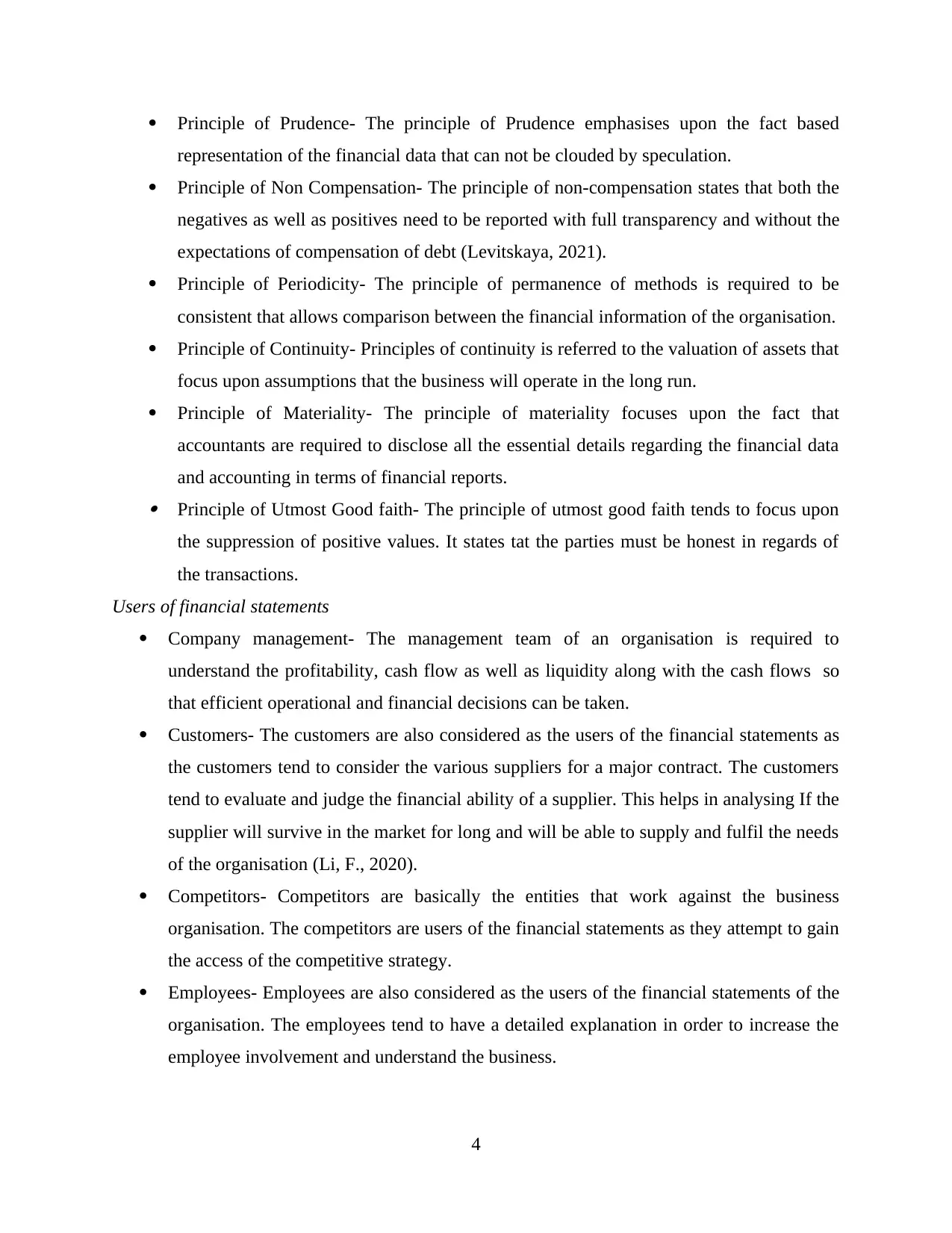
Principle of Prudence- The principle of Prudence emphasises upon the fact based
representation of the financial data that can not be clouded by speculation.
Principle of Non Compensation- The principle of non-compensation states that both the
negatives as well as positives need to be reported with full transparency and without the
expectations of compensation of debt (Levitskaya, 2021).
Principle of Periodicity- The principle of permanence of methods is required to be
consistent that allows comparison between the financial information of the organisation.
Principle of Continuity- Principles of continuity is referred to the valuation of assets that
focus upon assumptions that the business will operate in the long run.
Principle of Materiality- The principle of materiality focuses upon the fact that
accountants are required to disclose all the essential details regarding the financial data
and accounting in terms of financial reports. Principle of Utmost Good faith- The principle of utmost good faith tends to focus upon
the suppression of positive values. It states tat the parties must be honest in regards of
the transactions.
Users of financial statements
Company management- The management team of an organisation is required to
understand the profitability, cash flow as well as liquidity along with the cash flows so
that efficient operational and financial decisions can be taken.
Customers- The customers are also considered as the users of the financial statements as
the customers tend to consider the various suppliers for a major contract. The customers
tend to evaluate and judge the financial ability of a supplier. This helps in analysing If the
supplier will survive in the market for long and will be able to supply and fulfil the needs
of the organisation (Li, F., 2020).
Competitors- Competitors are basically the entities that work against the business
organisation. The competitors are users of the financial statements as they attempt to gain
the access of the competitive strategy.
Employees- Employees are also considered as the users of the financial statements of the
organisation. The employees tend to have a detailed explanation in order to increase the
employee involvement and understand the business.
4
representation of the financial data that can not be clouded by speculation.
Principle of Non Compensation- The principle of non-compensation states that both the
negatives as well as positives need to be reported with full transparency and without the
expectations of compensation of debt (Levitskaya, 2021).
Principle of Periodicity- The principle of permanence of methods is required to be
consistent that allows comparison between the financial information of the organisation.
Principle of Continuity- Principles of continuity is referred to the valuation of assets that
focus upon assumptions that the business will operate in the long run.
Principle of Materiality- The principle of materiality focuses upon the fact that
accountants are required to disclose all the essential details regarding the financial data
and accounting in terms of financial reports. Principle of Utmost Good faith- The principle of utmost good faith tends to focus upon
the suppression of positive values. It states tat the parties must be honest in regards of
the transactions.
Users of financial statements
Company management- The management team of an organisation is required to
understand the profitability, cash flow as well as liquidity along with the cash flows so
that efficient operational and financial decisions can be taken.
Customers- The customers are also considered as the users of the financial statements as
the customers tend to consider the various suppliers for a major contract. The customers
tend to evaluate and judge the financial ability of a supplier. This helps in analysing If the
supplier will survive in the market for long and will be able to supply and fulfil the needs
of the organisation (Li, F., 2020).
Competitors- Competitors are basically the entities that work against the business
organisation. The competitors are users of the financial statements as they attempt to gain
the access of the competitive strategy.
Employees- Employees are also considered as the users of the financial statements of the
organisation. The employees tend to have a detailed explanation in order to increase the
employee involvement and understand the business.
4
Paraphrase This Document
Need a fresh take? Get an instant paraphrase of this document with our AI Paraphraser
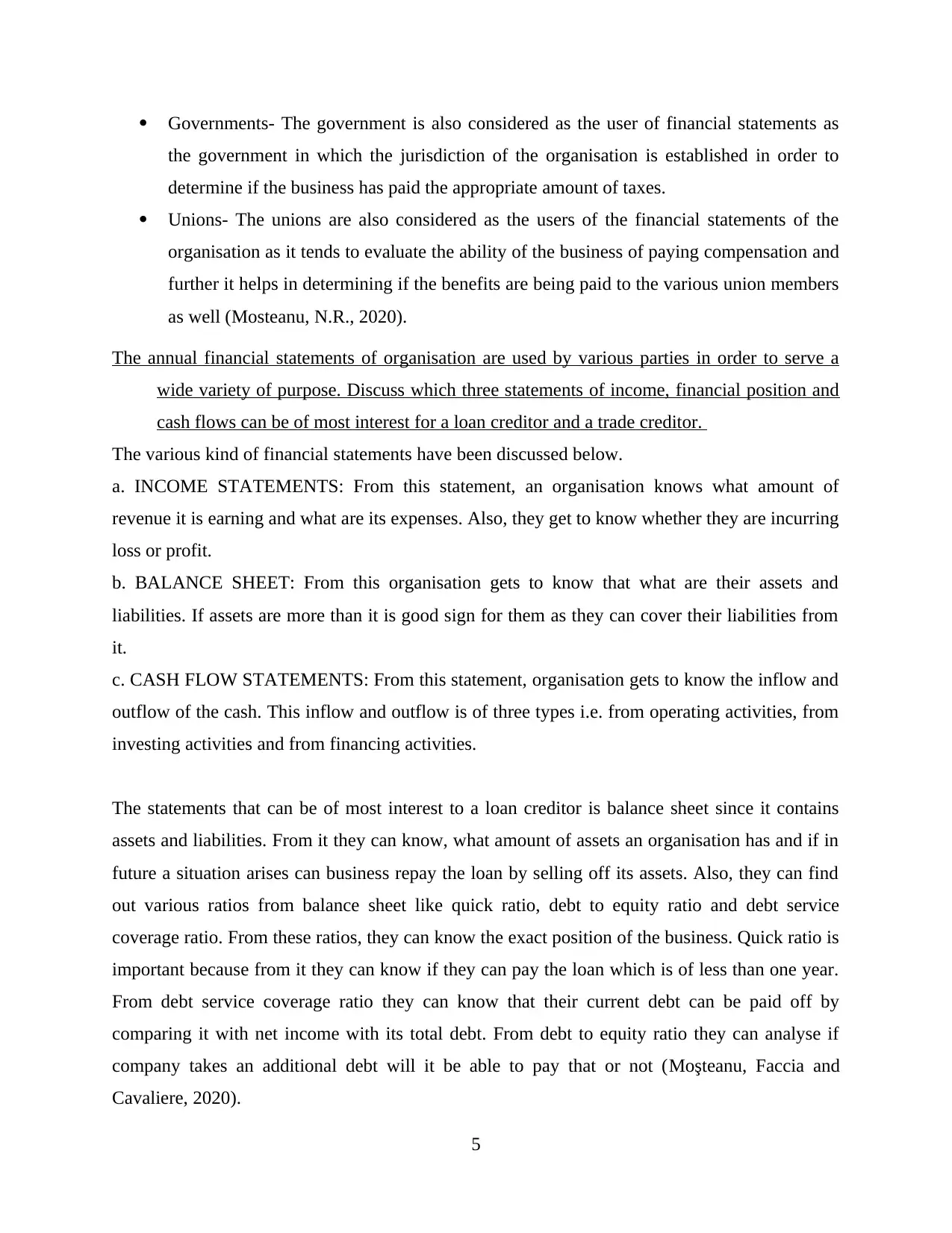
Governments- The government is also considered as the user of financial statements as
the government in which the jurisdiction of the organisation is established in order to
determine if the business has paid the appropriate amount of taxes.
Unions- The unions are also considered as the users of the financial statements of the
organisation as it tends to evaluate the ability of the business of paying compensation and
further it helps in determining if the benefits are being paid to the various union members
as well (Mosteanu, N.R., 2020).
The annual financial statements of organisation are used by various parties in order to serve a
wide variety of purpose. Discuss which three statements of income, financial position and
cash flows can be of most interest for a loan creditor and a trade creditor.
The various kind of financial statements have been discussed below.
a. INCOME STATEMENTS: From this statement, an organisation knows what amount of
revenue it is earning and what are its expenses. Also, they get to know whether they are incurring
loss or profit.
b. BALANCE SHEET: From this organisation gets to know that what are their assets and
liabilities. If assets are more than it is good sign for them as they can cover their liabilities from
it.
c. CASH FLOW STATEMENTS: From this statement, organisation gets to know the inflow and
outflow of the cash. This inflow and outflow is of three types i.e. from operating activities, from
investing activities and from financing activities.
The statements that can be of most interest to a loan creditor is balance sheet since it contains
assets and liabilities. From it they can know, what amount of assets an organisation has and if in
future a situation arises can business repay the loan by selling off its assets. Also, they can find
out various ratios from balance sheet like quick ratio, debt to equity ratio and debt service
coverage ratio. From these ratios, they can know the exact position of the business. Quick ratio is
important because from it they can know if they can pay the loan which is of less than one year.
From debt service coverage ratio they can know that their current debt can be paid off by
comparing it with net income with its total debt. From debt to equity ratio they can analyse if
company takes an additional debt will it be able to pay that or not (Moşteanu, Faccia and
Cavaliere, 2020).
5
the government in which the jurisdiction of the organisation is established in order to
determine if the business has paid the appropriate amount of taxes.
Unions- The unions are also considered as the users of the financial statements of the
organisation as it tends to evaluate the ability of the business of paying compensation and
further it helps in determining if the benefits are being paid to the various union members
as well (Mosteanu, N.R., 2020).
The annual financial statements of organisation are used by various parties in order to serve a
wide variety of purpose. Discuss which three statements of income, financial position and
cash flows can be of most interest for a loan creditor and a trade creditor.
The various kind of financial statements have been discussed below.
a. INCOME STATEMENTS: From this statement, an organisation knows what amount of
revenue it is earning and what are its expenses. Also, they get to know whether they are incurring
loss or profit.
b. BALANCE SHEET: From this organisation gets to know that what are their assets and
liabilities. If assets are more than it is good sign for them as they can cover their liabilities from
it.
c. CASH FLOW STATEMENTS: From this statement, organisation gets to know the inflow and
outflow of the cash. This inflow and outflow is of three types i.e. from operating activities, from
investing activities and from financing activities.
The statements that can be of most interest to a loan creditor is balance sheet since it contains
assets and liabilities. From it they can know, what amount of assets an organisation has and if in
future a situation arises can business repay the loan by selling off its assets. Also, they can find
out various ratios from balance sheet like quick ratio, debt to equity ratio and debt service
coverage ratio. From these ratios, they can know the exact position of the business. Quick ratio is
important because from it they can know if they can pay the loan which is of less than one year.
From debt service coverage ratio they can know that their current debt can be paid off by
comparing it with net income with its total debt. From debt to equity ratio they can analyse if
company takes an additional debt will it be able to pay that or not (Moşteanu, Faccia and
Cavaliere, 2020).
5
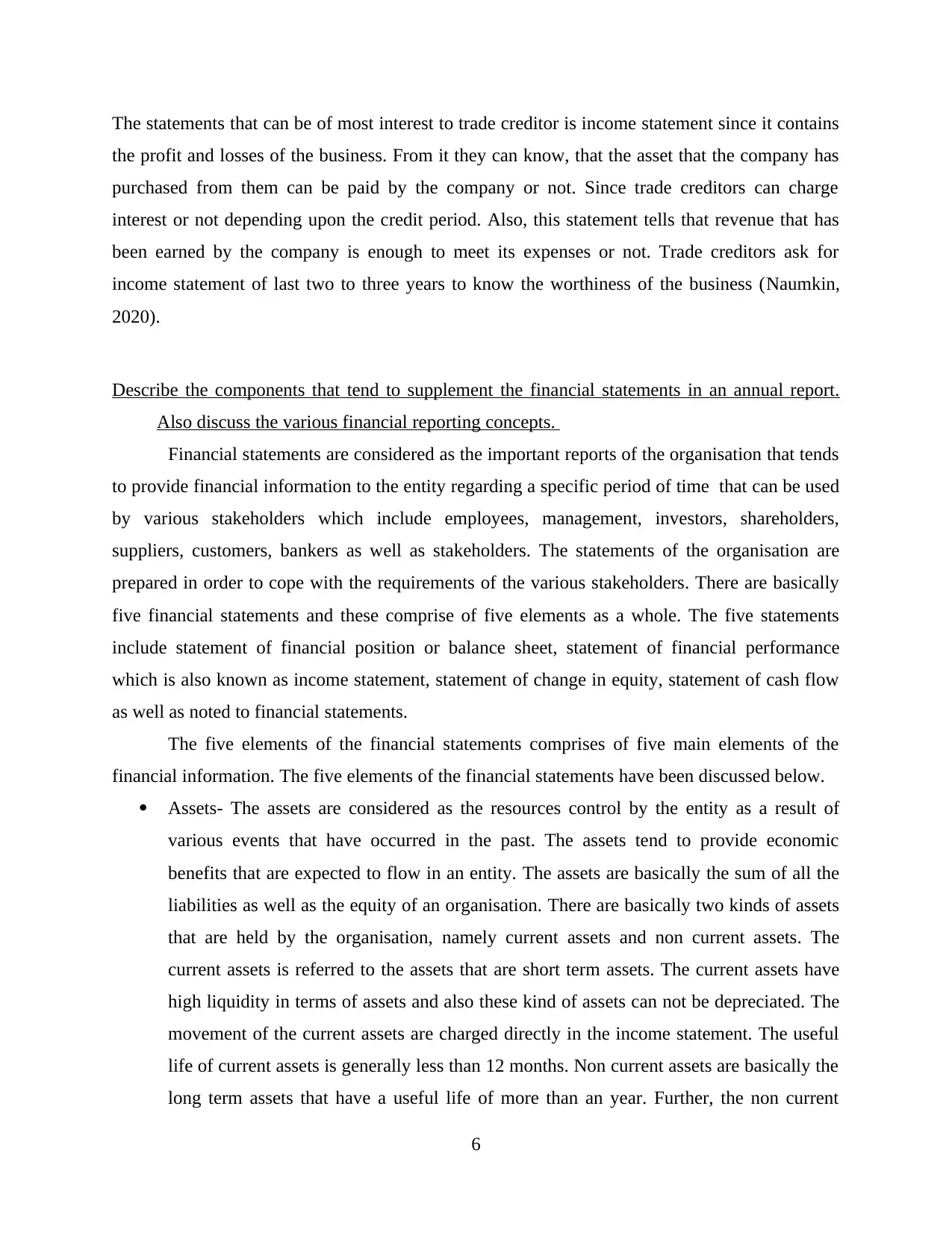
The statements that can be of most interest to trade creditor is income statement since it contains
the profit and losses of the business. From it they can know, that the asset that the company has
purchased from them can be paid by the company or not. Since trade creditors can charge
interest or not depending upon the credit period. Also, this statement tells that revenue that has
been earned by the company is enough to meet its expenses or not. Trade creditors ask for
income statement of last two to three years to know the worthiness of the business (Naumkin,
2020).
Describe the components that tend to supplement the financial statements in an annual report.
Also discuss the various financial reporting concepts.
Financial statements are considered as the important reports of the organisation that tends
to provide financial information to the entity regarding a specific period of time that can be used
by various stakeholders which include employees, management, investors, shareholders,
suppliers, customers, bankers as well as stakeholders. The statements of the organisation are
prepared in order to cope with the requirements of the various stakeholders. There are basically
five financial statements and these comprise of five elements as a whole. The five statements
include statement of financial position or balance sheet, statement of financial performance
which is also known as income statement, statement of change in equity, statement of cash flow
as well as noted to financial statements.
The five elements of the financial statements comprises of five main elements of the
financial information. The five elements of the financial statements have been discussed below.
Assets- The assets are considered as the resources control by the entity as a result of
various events that have occurred in the past. The assets tend to provide economic
benefits that are expected to flow in an entity. The assets are basically the sum of all the
liabilities as well as the equity of an organisation. There are basically two kinds of assets
that are held by the organisation, namely current assets and non current assets. The
current assets is referred to the assets that are short term assets. The current assets have
high liquidity in terms of assets and also these kind of assets can not be depreciated. The
movement of the current assets are charged directly in the income statement. The useful
life of current assets is generally less than 12 months. Non current assets are basically the
long term assets that have a useful life of more than an year. Further, the non current
6
the profit and losses of the business. From it they can know, that the asset that the company has
purchased from them can be paid by the company or not. Since trade creditors can charge
interest or not depending upon the credit period. Also, this statement tells that revenue that has
been earned by the company is enough to meet its expenses or not. Trade creditors ask for
income statement of last two to three years to know the worthiness of the business (Naumkin,
2020).
Describe the components that tend to supplement the financial statements in an annual report.
Also discuss the various financial reporting concepts.
Financial statements are considered as the important reports of the organisation that tends
to provide financial information to the entity regarding a specific period of time that can be used
by various stakeholders which include employees, management, investors, shareholders,
suppliers, customers, bankers as well as stakeholders. The statements of the organisation are
prepared in order to cope with the requirements of the various stakeholders. There are basically
five financial statements and these comprise of five elements as a whole. The five statements
include statement of financial position or balance sheet, statement of financial performance
which is also known as income statement, statement of change in equity, statement of cash flow
as well as noted to financial statements.
The five elements of the financial statements comprises of five main elements of the
financial information. The five elements of the financial statements have been discussed below.
Assets- The assets are considered as the resources control by the entity as a result of
various events that have occurred in the past. The assets tend to provide economic
benefits that are expected to flow in an entity. The assets are basically the sum of all the
liabilities as well as the equity of an organisation. There are basically two kinds of assets
that are held by the organisation, namely current assets and non current assets. The
current assets is referred to the assets that are short term assets. The current assets have
high liquidity in terms of assets and also these kind of assets can not be depreciated. The
movement of the current assets are charged directly in the income statement. The useful
life of current assets is generally less than 12 months. Non current assets are basically the
long term assets that have a useful life of more than an year. Further, the non current
6
⊘ This is a preview!⊘
Do you want full access?
Subscribe today to unlock all pages.

Trusted by 1+ million students worldwide
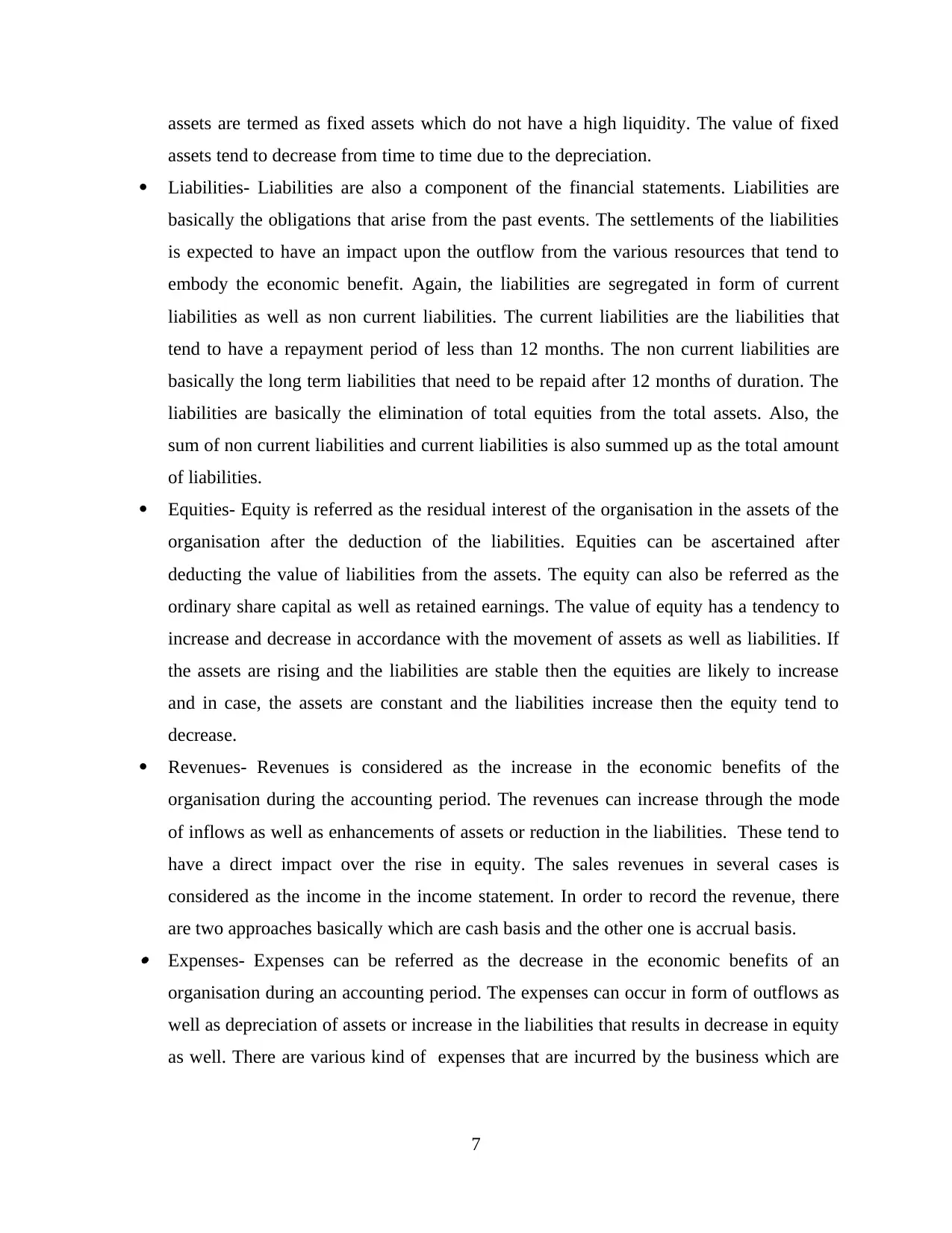
assets are termed as fixed assets which do not have a high liquidity. The value of fixed
assets tend to decrease from time to time due to the depreciation.
Liabilities- Liabilities are also a component of the financial statements. Liabilities are
basically the obligations that arise from the past events. The settlements of the liabilities
is expected to have an impact upon the outflow from the various resources that tend to
embody the economic benefit. Again, the liabilities are segregated in form of current
liabilities as well as non current liabilities. The current liabilities are the liabilities that
tend to have a repayment period of less than 12 months. The non current liabilities are
basically the long term liabilities that need to be repaid after 12 months of duration. The
liabilities are basically the elimination of total equities from the total assets. Also, the
sum of non current liabilities and current liabilities is also summed up as the total amount
of liabilities.
Equities- Equity is referred as the residual interest of the organisation in the assets of the
organisation after the deduction of the liabilities. Equities can be ascertained after
deducting the value of liabilities from the assets. The equity can also be referred as the
ordinary share capital as well as retained earnings. The value of equity has a tendency to
increase and decrease in accordance with the movement of assets as well as liabilities. If
the assets are rising and the liabilities are stable then the equities are likely to increase
and in case, the assets are constant and the liabilities increase then the equity tend to
decrease.
Revenues- Revenues is considered as the increase in the economic benefits of the
organisation during the accounting period. The revenues can increase through the mode
of inflows as well as enhancements of assets or reduction in the liabilities. These tend to
have a direct impact over the rise in equity. The sales revenues in several cases is
considered as the income in the income statement. In order to record the revenue, there
are two approaches basically which are cash basis and the other one is accrual basis. Expenses- Expenses can be referred as the decrease in the economic benefits of an
organisation during an accounting period. The expenses can occur in form of outflows as
well as depreciation of assets or increase in the liabilities that results in decrease in equity
as well. There are various kind of expenses that are incurred by the business which are
7
assets tend to decrease from time to time due to the depreciation.
Liabilities- Liabilities are also a component of the financial statements. Liabilities are
basically the obligations that arise from the past events. The settlements of the liabilities
is expected to have an impact upon the outflow from the various resources that tend to
embody the economic benefit. Again, the liabilities are segregated in form of current
liabilities as well as non current liabilities. The current liabilities are the liabilities that
tend to have a repayment period of less than 12 months. The non current liabilities are
basically the long term liabilities that need to be repaid after 12 months of duration. The
liabilities are basically the elimination of total equities from the total assets. Also, the
sum of non current liabilities and current liabilities is also summed up as the total amount
of liabilities.
Equities- Equity is referred as the residual interest of the organisation in the assets of the
organisation after the deduction of the liabilities. Equities can be ascertained after
deducting the value of liabilities from the assets. The equity can also be referred as the
ordinary share capital as well as retained earnings. The value of equity has a tendency to
increase and decrease in accordance with the movement of assets as well as liabilities. If
the assets are rising and the liabilities are stable then the equities are likely to increase
and in case, the assets are constant and the liabilities increase then the equity tend to
decrease.
Revenues- Revenues is considered as the increase in the economic benefits of the
organisation during the accounting period. The revenues can increase through the mode
of inflows as well as enhancements of assets or reduction in the liabilities. These tend to
have a direct impact over the rise in equity. The sales revenues in several cases is
considered as the income in the income statement. In order to record the revenue, there
are two approaches basically which are cash basis and the other one is accrual basis. Expenses- Expenses can be referred as the decrease in the economic benefits of an
organisation during an accounting period. The expenses can occur in form of outflows as
well as depreciation of assets or increase in the liabilities that results in decrease in equity
as well. There are various kind of expenses that are incurred by the business which are
7
Paraphrase This Document
Need a fresh take? Get an instant paraphrase of this document with our AI Paraphraser
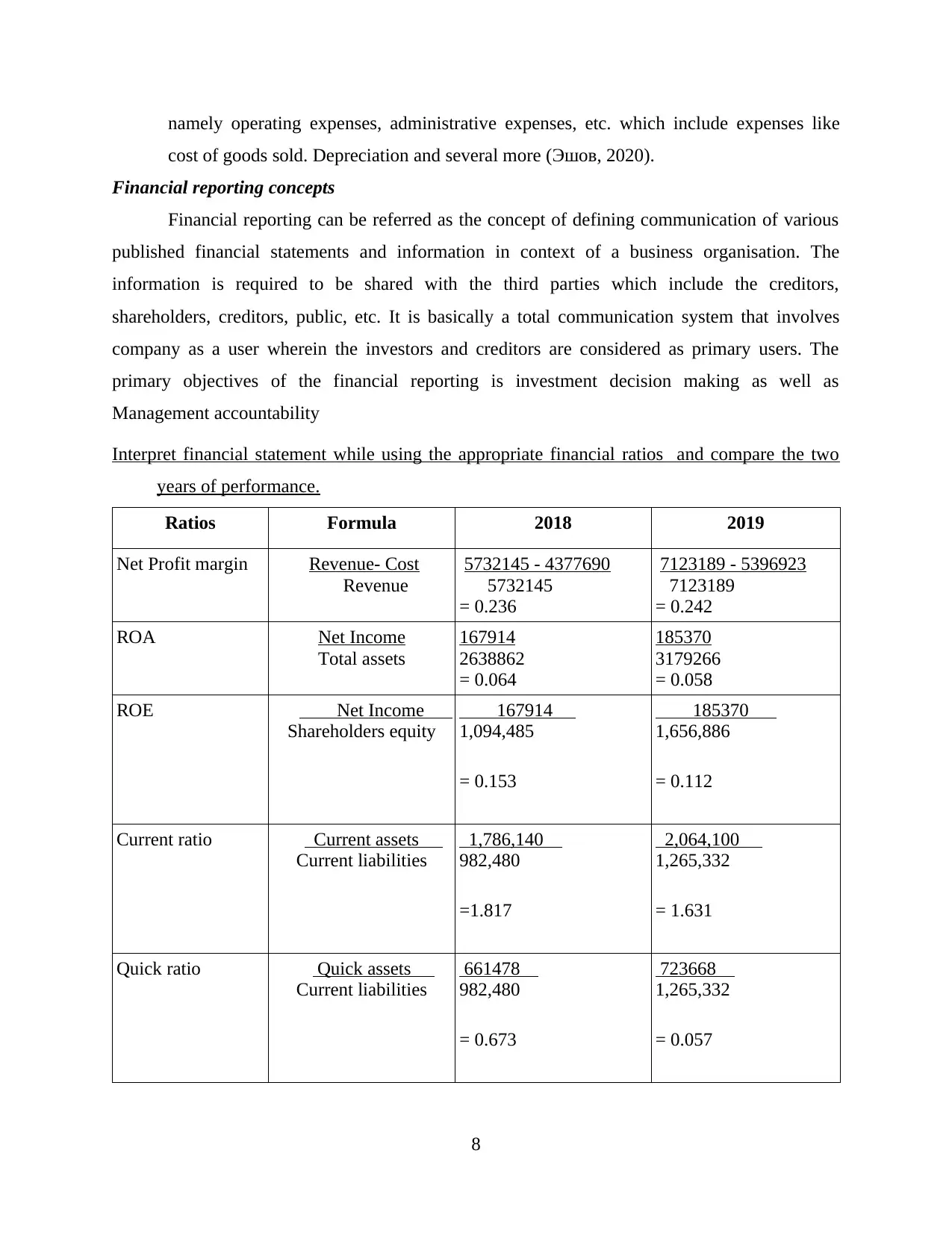
namely operating expenses, administrative expenses, etc. which include expenses like
cost of goods sold. Depreciation and several more (Эшов, 2020).
Financial reporting concepts
Financial reporting can be referred as the concept of defining communication of various
published financial statements and information in context of a business organisation. The
information is required to be shared with the third parties which include the creditors,
shareholders, creditors, public, etc. It is basically a total communication system that involves
company as a user wherein the investors and creditors are considered as primary users. The
primary objectives of the financial reporting is investment decision making as well as
Management accountability
Interpret financial statement while using the appropriate financial ratios and compare the two
years of performance.
Ratios Formula 2018 2019
Net Profit margin Revenue- Cost
Revenue
5732145 - 4377690
5732145
= 0.236
7123189 - 5396923
7123189
= 0.242
ROA Net Income
Total assets
167914
2638862
= 0.064
185370
3179266
= 0.058
ROE Net Income
Shareholders equity
167914
1,094,485
= 0.153
185370
1,656,886
= 0.112
Current ratio Current assets
Current liabilities
1,786,140
982,480
=1.817
2,064,100
1,265,332
= 1.631
Quick ratio Quick assets
Current liabilities
661478
982,480
= 0.673
723668
1,265,332
= 0.057
8
cost of goods sold. Depreciation and several more (Эшов, 2020).
Financial reporting concepts
Financial reporting can be referred as the concept of defining communication of various
published financial statements and information in context of a business organisation. The
information is required to be shared with the third parties which include the creditors,
shareholders, creditors, public, etc. It is basically a total communication system that involves
company as a user wherein the investors and creditors are considered as primary users. The
primary objectives of the financial reporting is investment decision making as well as
Management accountability
Interpret financial statement while using the appropriate financial ratios and compare the two
years of performance.
Ratios Formula 2018 2019
Net Profit margin Revenue- Cost
Revenue
5732145 - 4377690
5732145
= 0.236
7123189 - 5396923
7123189
= 0.242
ROA Net Income
Total assets
167914
2638862
= 0.064
185370
3179266
= 0.058
ROE Net Income
Shareholders equity
167914
1,094,485
= 0.153
185370
1,656,886
= 0.112
Current ratio Current assets
Current liabilities
1,786,140
982,480
=1.817
2,064,100
1,265,332
= 1.631
Quick ratio Quick assets
Current liabilities
661478
982,480
= 0.673
723668
1,265,332
= 0.057
8
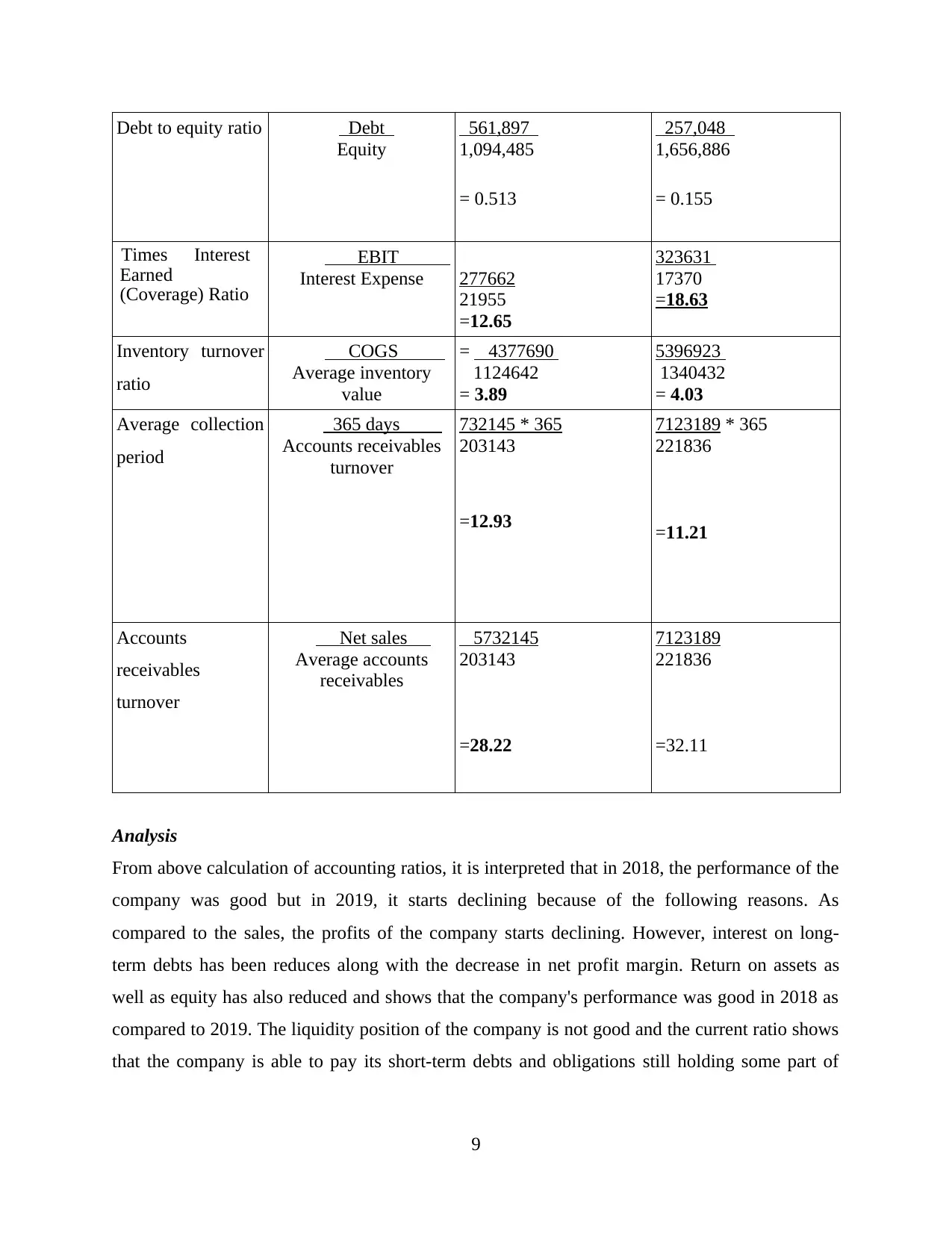
Debt to equity ratio Debt
Equity
561,897
1,094,485
= 0.513
257,048
1,656,886
= 0.155
Times Interest
Earned
(Coverage) Ratio
EBIT
Interest Expense 277662
21955
=12.65
323631
17370
=18.63
Inventory turnover
ratio
COGS
Average inventory
value
= 4377690
1124642
= 3.89
5396923
1340432
= 4.03
Average collection
period
365 days
Accounts receivables
turnover
732145 * 365
203143
=12.93
7123189 * 365
221836
=11.21
Accounts
receivables
turnover
Net sales
Average accounts
receivables
5732145
203143
=28.22
7123189
221836
=32.11
Analysis
From above calculation of accounting ratios, it is interpreted that in 2018, the performance of the
company was good but in 2019, it starts declining because of the following reasons. As
compared to the sales, the profits of the company starts declining. However, interest on long-
term debts has been reduces along with the decrease in net profit margin. Return on assets as
well as equity has also reduced and shows that the company's performance was good in 2018 as
compared to 2019. The liquidity position of the company is not good and the current ratio shows
that the company is able to pay its short-term debts and obligations still holding some part of
9
Equity
561,897
1,094,485
= 0.513
257,048
1,656,886
= 0.155
Times Interest
Earned
(Coverage) Ratio
EBIT
Interest Expense 277662
21955
=12.65
323631
17370
=18.63
Inventory turnover
ratio
COGS
Average inventory
value
= 4377690
1124642
= 3.89
5396923
1340432
= 4.03
Average collection
period
365 days
Accounts receivables
turnover
732145 * 365
203143
=12.93
7123189 * 365
221836
=11.21
Accounts
receivables
turnover
Net sales
Average accounts
receivables
5732145
203143
=28.22
7123189
221836
=32.11
Analysis
From above calculation of accounting ratios, it is interpreted that in 2018, the performance of the
company was good but in 2019, it starts declining because of the following reasons. As
compared to the sales, the profits of the company starts declining. However, interest on long-
term debts has been reduces along with the decrease in net profit margin. Return on assets as
well as equity has also reduced and shows that the company's performance was good in 2018 as
compared to 2019. The liquidity position of the company is not good and the current ratio shows
that the company is able to pay its short-term debts and obligations still holding some part of
9
⊘ This is a preview!⊘
Do you want full access?
Subscribe today to unlock all pages.

Trusted by 1+ million students worldwide
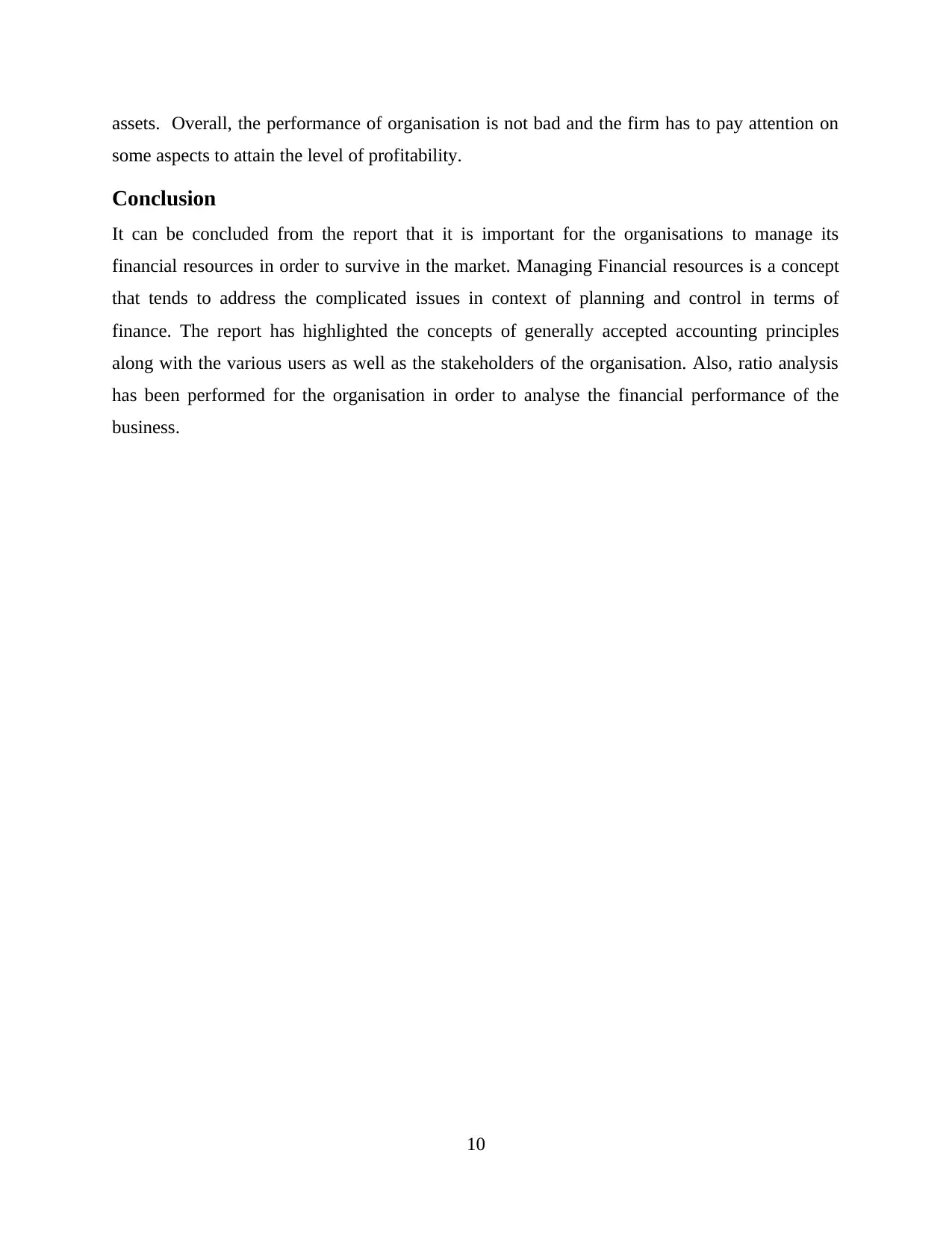
assets. Overall, the performance of organisation is not bad and the firm has to pay attention on
some aspects to attain the level of profitability.
Conclusion
It can be concluded from the report that it is important for the organisations to manage its
financial resources in order to survive in the market. Managing Financial resources is a concept
that tends to address the complicated issues in context of planning and control in terms of
finance. The report has highlighted the concepts of generally accepted accounting principles
along with the various users as well as the stakeholders of the organisation. Also, ratio analysis
has been performed for the organisation in order to analyse the financial performance of the
business.
10
some aspects to attain the level of profitability.
Conclusion
It can be concluded from the report that it is important for the organisations to manage its
financial resources in order to survive in the market. Managing Financial resources is a concept
that tends to address the complicated issues in context of planning and control in terms of
finance. The report has highlighted the concepts of generally accepted accounting principles
along with the various users as well as the stakeholders of the organisation. Also, ratio analysis
has been performed for the organisation in order to analyse the financial performance of the
business.
10
Paraphrase This Document
Need a fresh take? Get an instant paraphrase of this document with our AI Paraphraser
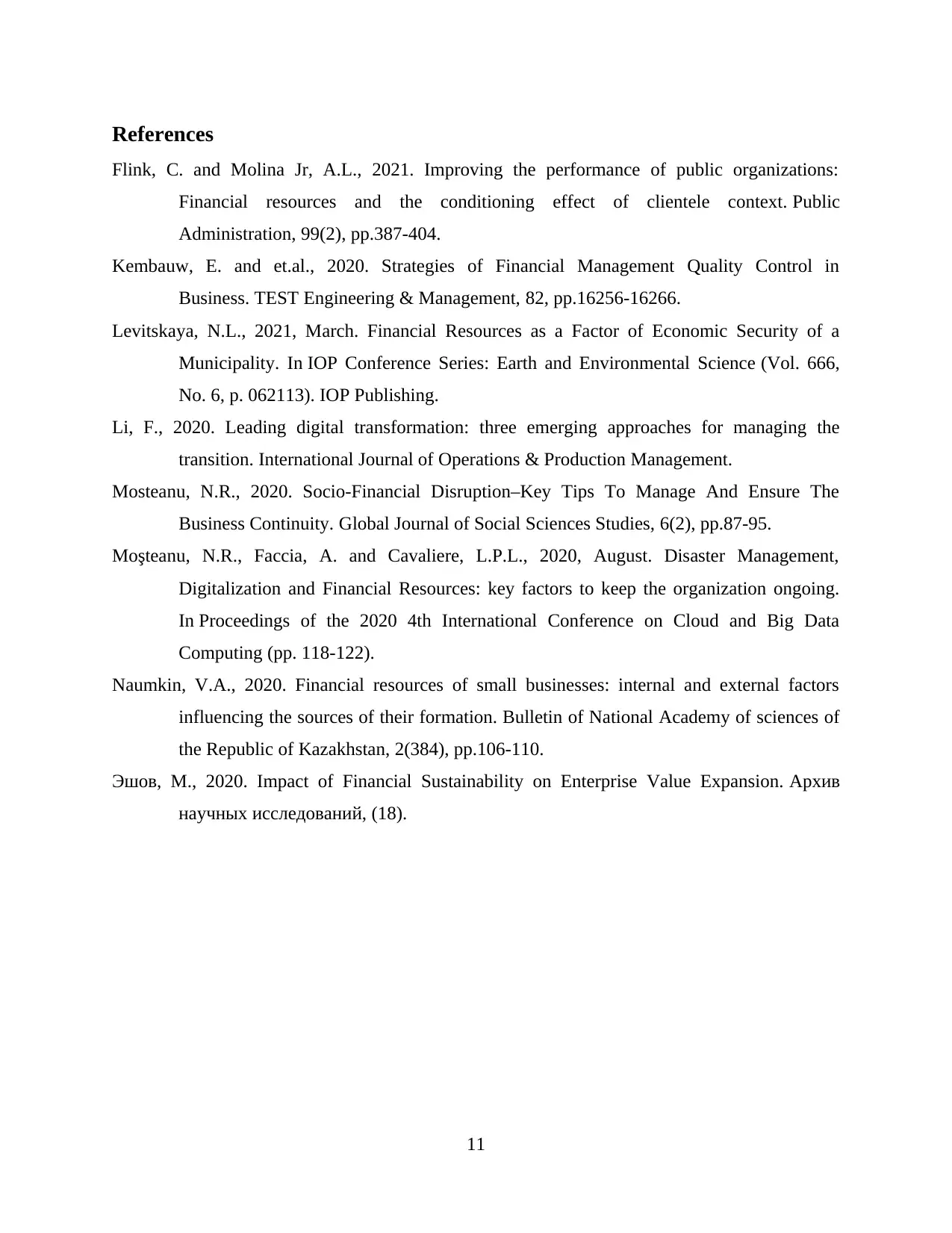
References
Flink, C. and Molina Jr, A.L., 2021. Improving the performance of public organizations:
Financial resources and the conditioning effect of clientele context. Public
Administration, 99(2), pp.387-404.
Kembauw, E. and et.al., 2020. Strategies of Financial Management Quality Control in
Business. TEST Engineering & Management, 82, pp.16256-16266.
Levitskaya, N.L., 2021, March. Financial Resources as a Factor of Economic Security of a
Municipality. In IOP Conference Series: Earth and Environmental Science (Vol. 666,
No. 6, p. 062113). IOP Publishing.
Li, F., 2020. Leading digital transformation: three emerging approaches for managing the
transition. International Journal of Operations & Production Management.
Mosteanu, N.R., 2020. Socio-Financial Disruption–Key Tips To Manage And Ensure The
Business Continuity. Global Journal of Social Sciences Studies, 6(2), pp.87-95.
Moşteanu, N.R., Faccia, A. and Cavaliere, L.P.L., 2020, August. Disaster Management,
Digitalization and Financial Resources: key factors to keep the organization ongoing.
In Proceedings of the 2020 4th International Conference on Cloud and Big Data
Computing (pp. 118-122).
Naumkin, V.A., 2020. Financial resources of small businesses: internal and external factors
influencing the sources of their formation. Bulletin of National Academy of sciences of
the Republic of Kazakhstan, 2(384), pp.106-110.
Эшов, М., 2020. Impact of Financial Sustainability on Enterprise Value Expansion. Архив
научных исследований, (18).
11
Flink, C. and Molina Jr, A.L., 2021. Improving the performance of public organizations:
Financial resources and the conditioning effect of clientele context. Public
Administration, 99(2), pp.387-404.
Kembauw, E. and et.al., 2020. Strategies of Financial Management Quality Control in
Business. TEST Engineering & Management, 82, pp.16256-16266.
Levitskaya, N.L., 2021, March. Financial Resources as a Factor of Economic Security of a
Municipality. In IOP Conference Series: Earth and Environmental Science (Vol. 666,
No. 6, p. 062113). IOP Publishing.
Li, F., 2020. Leading digital transformation: three emerging approaches for managing the
transition. International Journal of Operations & Production Management.
Mosteanu, N.R., 2020. Socio-Financial Disruption–Key Tips To Manage And Ensure The
Business Continuity. Global Journal of Social Sciences Studies, 6(2), pp.87-95.
Moşteanu, N.R., Faccia, A. and Cavaliere, L.P.L., 2020, August. Disaster Management,
Digitalization and Financial Resources: key factors to keep the organization ongoing.
In Proceedings of the 2020 4th International Conference on Cloud and Big Data
Computing (pp. 118-122).
Naumkin, V.A., 2020. Financial resources of small businesses: internal and external factors
influencing the sources of their formation. Bulletin of National Academy of sciences of
the Republic of Kazakhstan, 2(384), pp.106-110.
Эшов, М., 2020. Impact of Financial Sustainability on Enterprise Value Expansion. Архив
научных исследований, (18).
11

12
⊘ This is a preview!⊘
Do you want full access?
Subscribe today to unlock all pages.

Trusted by 1+ million students worldwide
1 out of 12
Related Documents
Your All-in-One AI-Powered Toolkit for Academic Success.
+13062052269
info@desklib.com
Available 24*7 on WhatsApp / Email
![[object Object]](/_next/static/media/star-bottom.7253800d.svg)
Unlock your academic potential
Copyright © 2020–2025 A2Z Services. All Rights Reserved. Developed and managed by ZUCOL.
